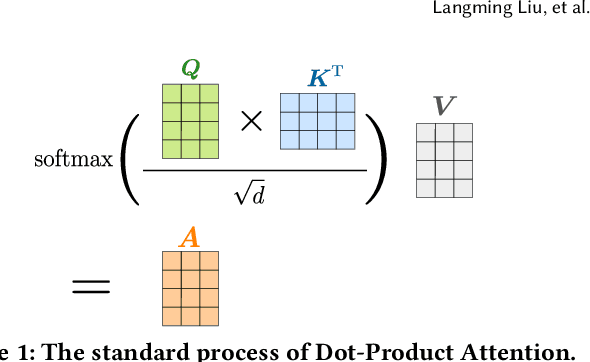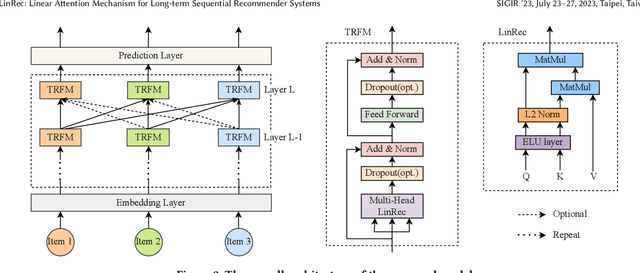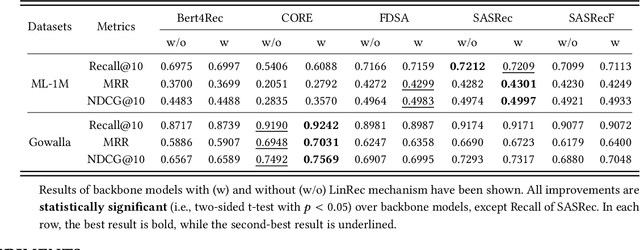Zitao Liu
Behavior Modeling Space Reconstruction for E-Commerce Search
Jan 30, 2025



Abstract:Delivering superior search services is crucial for enhancing customer experience and driving revenue growth. Conventionally, search systems model user behaviors by combining user preference and query item relevance statically, often through a fixed logical 'and' relationship. This paper reexamines existing approaches through a unified lens using both causal graphs and Venn diagrams, uncovering two prevalent yet significant issues: entangled preference and relevance effects, and a collapsed modeling space. To surmount these challenges, our research introduces a novel framework, DRP, which enhances search accuracy through two components to reconstruct the behavior modeling space. Specifically, we implement preference editing to proactively remove the relevance effect from preference predictions, yielding untainted user preferences. Additionally, we employ adaptive fusion, which dynamically adjusts fusion criteria to align with the varying patterns of relevance and preference, facilitating more nuanced and tailored behavior predictions within the reconstructed modeling space. Empirical validation on two public datasets and a proprietary search dataset underscores the superiority of our proposed methodology, demonstrating marked improvements in performance over existing approaches.
Advancing Math Reasoning in Language Models: The Impact of Problem-Solving Data, Data Synthesis Methods, and Training Stages
Jan 23, 2025Abstract:Advancements in LLMs have significantly expanded their capabilities across various domains. However, mathematical reasoning remains a challenging area, prompting the development of math-specific LLMs. These models typically follow a two-stage training paradigm: pre-training with math-related corpora and post-training with problem datasets for SFT. Despite these efforts, the improvements in mathematical reasoning achieved through continued pre-training (CPT) are often less significant compared to those obtained via SFT. This study addresses this discrepancy by exploring alternative strategies during the pre-training phase, focusing on the use of problem-solving data over general mathematical corpora. We investigate three primary research questions: (1) Can problem-solving data enhance the model's mathematical reasoning capabilities more effectively than general mathematical corpora during CPT? (2) Are synthetic data from the same source equally effective, and which synthesis methods are most efficient? (3) How do the capabilities developed from the same problem-solving data differ between the CPT and SFT stages, and what factors contribute to these differences? Our findings indicate that problem-solving data significantly enhances the model's mathematical capabilities compared to general mathematical corpora. We also identify effective data synthesis methods, demonstrating that the tutorship amplification synthesis method achieves the best performance. Furthermore, while SFT facilitates instruction-following abilities, it underperforms compared to CPT with the same data, which can be partially attributed to its poor learning capacity for hard multi-step problem-solving data. These insights provide valuable guidance for optimizing the mathematical reasoning capabilities of LLMs, culminating in our development of a powerful mathematical base model called JiuZhang-8B.
What Are Step-Level Reward Models Rewarding? Counterintuitive Findings from MCTS-Boosted Mathematical Reasoning
Dec 20, 2024Abstract:Step-level reward models (SRMs) can significantly enhance mathematical reasoning performance through process supervision or step-level preference alignment based on reinforcement learning. The performance of SRMs is pivotal, as they serve as critical guidelines, ensuring that each step in the reasoning process is aligned with desired outcomes. Recently, AlphaZero-like methods, where Monte Carlo Tree Search (MCTS) is employed for automatic step-level preference annotation, have proven particularly effective. However, the precise mechanisms behind the success of SRMs remain largely unexplored. To address this gap, this study delves into the counterintuitive aspects of SRMs, particularly focusing on MCTS-based approaches. Our findings reveal that the removal of natural language descriptions of thought processes has minimal impact on the efficacy of SRMs. Furthermore, we demonstrate that SRMs are adept at assessing the complex logical coherence present in mathematical language while having difficulty in natural language. These insights provide a nuanced understanding of the core elements that drive effective step-level reward modeling in mathematical reasoning. By shedding light on these mechanisms, this study offers valuable guidance for developing more efficient and streamlined SRMs, which can be achieved by focusing on the crucial parts of mathematical reasoning.
LinRec: Linear Attention Mechanism for Long-term Sequential Recommender Systems
Nov 03, 2024



Abstract:Transformer models have achieved remarkable success in sequential recommender systems (SRSs). However, computing the attention matrix in traditional dot-product attention mechanisms results in a quadratic complexity with sequence lengths, leading to high computational costs for long-term sequential recommendation. Motivated by the above observation, we propose a novel L2-Normalized Linear Attention for the Transformer-based Sequential Recommender Systems (LinRec), which theoretically improves efficiency while preserving the learning capabilities of the traditional dot-product attention. Specifically, by thoroughly examining the equivalence conditions of efficient attention mechanisms, we show that LinRec possesses linear complexity while preserving the property of attention mechanisms. In addition, we reveal its latent efficiency properties by interpreting the proposed LinRec mechanism through a statistical lens. Extensive experiments are conducted based on two public benchmark datasets, demonstrating that the combination of LinRec and Transformer models achieves comparable or even superior performance than state-of-the-art Transformer-based SRS models while significantly improving time and memory efficiency.
Efficient and Robust Regularized Federated Recommendation
Nov 03, 2024



Abstract:Recommender systems play a pivotal role across practical scenarios, showcasing remarkable capabilities in user preference modeling. However, the centralized learning paradigm predominantly used raises serious privacy concerns. The federated recommender system (FedRS) addresses this by updating models on clients, while a central server orchestrates training without accessing private data. Existing FedRS approaches, however, face unresolved challenges, including non-convex optimization, vulnerability, potential privacy leakage risk, and communication inefficiency. This paper addresses these challenges by reformulating the federated recommendation problem as a convex optimization issue, ensuring convergence to the global optimum. Based on this, we devise a novel method, RFRec, to tackle this optimization problem efficiently. In addition, we propose RFRecF, a highly efficient version that incorporates non-uniform stochastic gradient descent to improve communication efficiency. In user preference modeling, both methods learn local and global models, collaboratively learning users' common and personalized interests under the federated learning setting. Moreover, both methods significantly enhance communication efficiency, robustness, and privacy protection, with theoretical support. Comprehensive evaluations on four benchmark datasets demonstrate RFRec and RFRecF's superior performance compared to diverse baselines.
Expediting and Elevating Large Language Model Reasoning via Hidden Chain-of-Thought Decoding
Sep 13, 2024Abstract:Large language models (LLMs) have demonstrated remarkable capabilities in tasks requiring reasoning and multi-step problem-solving through the use of chain-of-thought (CoT) prompting. However, generating the full CoT process results in significantly longer output sequences, leading to increased computational costs and latency during inference. To address this challenge, we propose a novel approach to compress the CoT process through semantic alignment, enabling more efficient decoding while preserving the benefits of CoT reasoning. Our method introduces an auxiliary CoT model that learns to generate and compress the full thought process into a compact special token representation semantically aligned with the original CoT output. This compressed representation is then integrated into the input of the Hidden Chain-of-Thought (HCoT) model. The training process follows a two-stage procedure: First, the CoT model is optimized to generate the compressed token representations aligned with the ground-truth CoT outputs using a contrastive loss. Subsequently, with the CoT model parameters frozen, the HCoT model is fine-tuned to generate accurate subsequent predictions conditioned on the prefix instruction and the compressed CoT representations from the CoT model. Extensive experiments across three challenging domains - mathematical reasoning, agent invocation, and question answering - demonstrate that our semantic compression approach achieves competitive or improved performance compared to the full CoT baseline, while providing significant speedups of at least 1.5x in decoding time. Moreover, incorporating contrastive learning objectives further enhances the quality of the compressed representations, leading to better CoT prompting and improved task accuracy. Our work paves the way for more efficient exploitation of multi-step reasoning capabilities in LLMs across a wide range of applications.
Personalized Knowledge Tracing through Student Representation Reconstruction and Class Imbalance Mitigation
Sep 10, 2024



Abstract:Knowledge tracing is a technique that predicts students' future performance by analyzing their learning process through historical interactions with intelligent educational platforms, enabling a precise evaluation of their knowledge mastery. Recent studies have achieved significant progress by leveraging powerful deep neural networks. These models construct complex input representations using questions, skills, and other auxiliary information but overlook individual student characteristics, which limits the capability for personalized assessment. Additionally, the available datasets in the field exhibit class imbalance issues. The models that simply predict all responses as correct without substantial effort can yield impressive accuracy. In this paper, we propose PKT, a novel approach for personalized knowledge tracing. PKT reconstructs representations from sequences of interactions with a tutoring platform to capture latent information about the students. Moreover, PKT incorporates focal loss to improve prioritize minority classes, thereby achieving more balanced predictions. Extensive experimental results on four publicly available educational datasets demonstrate the advanced predictive performance of PKT in comparison with 16 state-of-the-art models. To ensure the reproducibility of our research, the code is publicly available at https://anonymous.4open.science/r/PKT.
Bidirectional Gated Mamba for Sequential Recommendation
Aug 21, 2024



Abstract:In various domains, Sequential Recommender Systems (SRS) have become essential due to their superior capability to discern intricate user preferences. Typically, SRS utilize transformer-based architectures to forecast the subsequent item within a sequence. Nevertheless, the quadratic computational complexity inherent in these models often leads to inefficiencies, hindering the achievement of real-time recommendations. Mamba, a recent advancement, has exhibited exceptional performance in time series prediction, significantly enhancing both efficiency and accuracy. However, integrating Mamba directly into SRS poses several challenges. Its inherently unidirectional nature may constrain the model's capacity to capture the full context of user-item interactions, while its instability in state estimation can compromise its ability to detect short-term patterns within interaction sequences. To overcome these issues, we introduce a new framework named \textbf{\underline{S}}elect\textbf{\underline{I}}ve \textbf{\underline{G}}ated \textbf{\underline{MA}}mba (SIGMA). This framework leverages a Partially Flipped Mamba (PF-Mamba) to construct a bidirectional architecture specifically tailored to improve contextual modeling. Additionally, an input-sensitive Dense Selective Gate (DS Gate) is employed to optimize directional weights and enhance the processing of sequential information in PF-Mamba. For short sequence modeling, we have also developed a Feature Extract GRU (FE-GRU) to efficiently capture short-term dependencies. Empirical results indicate that SIGMA outperforms current models on five real-world datasets. Our implementation code is available at \url{https://github.com/ziwliu-cityu/SIMGA} to ease reproducibility.
Towards Robust Knowledge Tracing Models via k-Sparse Attention
Jul 24, 2024Abstract:Knowledge tracing (KT) is the problem of predicting students' future performance based on their historical interaction sequences. With the advanced capability of capturing contextual long-term dependency, attention mechanism becomes one of the essential components in many deep learning based KT (DLKT) models. In spite of the impressive performance achieved by these attentional DLKT models, many of them are often vulnerable to run the risk of overfitting, especially on small-scale educational datasets. Therefore, in this paper, we propose \textsc{sparseKT}, a simple yet effective framework to improve the robustness and generalization of the attention based DLKT approaches. Specifically, we incorporate a k-selection module to only pick items with the highest attention scores. We propose two sparsification heuristics : (1) soft-thresholding sparse attention and (2) top-$K$ sparse attention. We show that our \textsc{sparseKT} is able to help attentional KT models get rid of irrelevant student interactions and have comparable predictive performance when compared to 11 state-of-the-art KT models on three publicly available real-world educational datasets. To encourage reproducible research, we make our data and code publicly available at \url{https://github.com/pykt-team/pykt-toolkit}\footnote{We merged our model to the \textsc{pyKT} benchmark at \url{https://pykt.org/}.}.
GUI Odyssey: A Comprehensive Dataset for Cross-App GUI Navigation on Mobile Devices
Jun 12, 2024



Abstract:Smartphone users often navigate across multiple applications (apps) to complete tasks such as sharing content between social media platforms. Autonomous Graphical User Interface (GUI) navigation agents can enhance user experience in communication, entertainment, and productivity by streamlining workflows and reducing manual intervention. However, prior GUI agents often trained with datasets comprising simple tasks that can be completed within a single app, leading to poor performance in cross-app navigation. To address this problem, we introduce GUI Odyssey, a comprehensive dataset for training and evaluating cross-app navigation agents. GUI Odyssey consists of 7,735 episodes from 6 mobile devices, spanning 6 types of cross-app tasks, 201 apps, and 1.4K app combos. Leveraging GUI Odyssey, we developed OdysseyAgent, a multimodal cross-app navigation agent by fine-tuning the Qwen-VL model with a history resampling module. Extensive experiments demonstrate OdysseyAgent's superior accuracy compared to existing models. For instance, OdysseyAgent surpasses fine-tuned Qwen-VL and zero-shot GPT-4V by 1.44\% and 55.49\% in-domain accuracy, and 2.29\% and 48.14\% out-of-domain accuracy on average. The dataset and code will be released in \url{https://github.com/OpenGVLab/GUI-Odyssey}.
 Add to Chrome
Add to Chrome Add to Firefox
Add to Firefox Add to Edge
Add to Edge